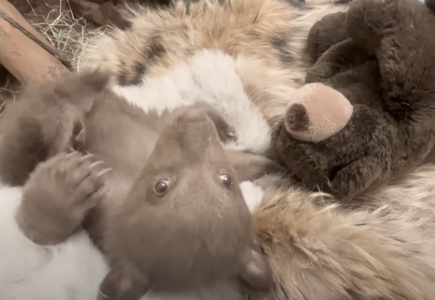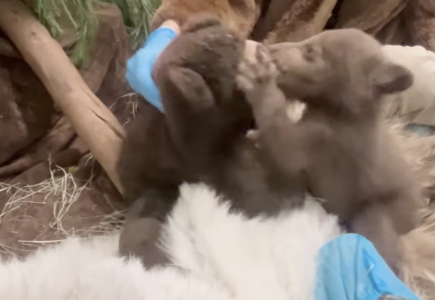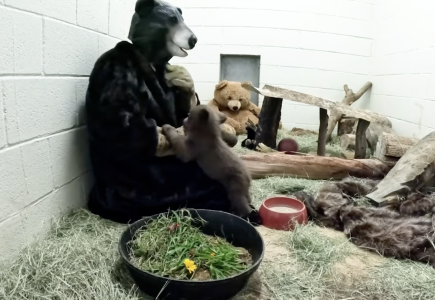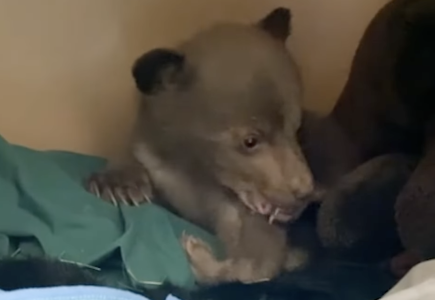He was left behind—now he’s America’s favorite baby bear!
- Replies 0
If you’re in need of a little good news—and who isn’t these days?—let us introduce you to the pint-sized, fuzzy hero currently stealing hearts at the San Diego Humane Society’s Ramona Wildlife Center.
This two-month-old black bear cub’s story is one of resilience, compassion, and a whole lot of creative caretaking.
Grab your cup of coffee, settle in, and prepare for a tale that’s as heartwarming as it is fascinating.
Our story begins in the rugged beauty of California’s Los Padres National Forest, where a group of campers stumbled upon a heartbreaking sight: a tiny, weak, and very much alone bear cub.
At just two months old, this little guy was facing the world without his mother—a situation that’s as rare as it is dangerous for a bear so young.
Wildlife biologists from the California Department of Fish and Wildlife (CDFW) sprang into action, hoping for a storybook reunion.
They returned the cub to the forest overnight, giving his mother a chance to come back.

But as dawn broke, it was clear: mama bear was nowhere to be found. With no sign of her and the cub’s health rapidly declining, the decision was made to bring him to the experts at the Ramona Wildlife Center.
A Fragile Beginning—and a Fierce Fight for Survival
“When he arrived, he was extremely fragile,” recalls Autumn Welch, Wildlife Operations Manager at the center. “It’s very unusual to see a bear this young without his mother.”

The cub was underweight, dehydrated, and suffering from health issues that made his survival anything but certain. For several days, it was touch-and-go.
But if there’s one thing this little bear has in spades, it’s spirit. Thanks to round-the-clock care—including overnight feedings and constant monitoring—he began to rally.
Also read: That high-tech mask from the movies? A former CIA expert says it’s more real than you think
Today, he’s not just surviving; he’s thriving. He’s active, eating well, and steadily gaining weight.
And, as the photos show, he’s also developing a healthy curiosity about the world around him.
Creative Care: Costumes, Cuddles, and Cub Enrichment
Now, here’s where things get downright delightful.
To ensure the cub doesn’t become too attached to humans—a process called “imprinting” that could make it impossible for him to return to the wild—his caregivers have gotten creative.

Staff don full-body wildlife costumes and mimic maternal bear behaviors during feeding and enrichment sessions.
Imagine a room full of adults in bear suits, bottle-feeding a cub and teaching him how to play with leaves and toys. It’s as adorable (and hilarious) as it sounds, but it’s also crucial for his development.

The cub receives four enrichment and feeding sessions each day, designed to stimulate his mind and body.
He’s learning to forage, play, and explore—skills he’ll need if he’s to make it on his own one day.
Source: ABC 10 News / Youtube.
And yes, there are plenty of toys, leaves to chew, and bottles to drink from. (We dare you not to smile at the photos.)
If you’re moved by this story (and who wouldn’t be?), consider supporting your local wildlife rescue or the San Diego Humane Society.
“It's an honor to care for him, but it's also a significant commitment. We rely entirely on donations to make this kind of specialized care possible,” Welch said.
Every little bit helps ensure that animals like our bear cub get a second chance at life.
Read next: This gorgeous 1962 Chevy just sold for $2,422—was it the deal of the decade?

Have you ever encountered wildlife in need? Do you have a favorite animal rescue story, or tips for supporting local shelters? Maybe you’re curious about what it takes to care for a wild animal, or you have questions about black bears in California. We’d love to hear your thoughts, stories, and questions in the comments below!
This two-month-old black bear cub’s story is one of resilience, compassion, and a whole lot of creative caretaking.
Grab your cup of coffee, settle in, and prepare for a tale that’s as heartwarming as it is fascinating.
Our story begins in the rugged beauty of California’s Los Padres National Forest, where a group of campers stumbled upon a heartbreaking sight: a tiny, weak, and very much alone bear cub.
At just two months old, this little guy was facing the world without his mother—a situation that’s as rare as it is dangerous for a bear so young.
Wildlife biologists from the California Department of Fish and Wildlife (CDFW) sprang into action, hoping for a storybook reunion.
They returned the cub to the forest overnight, giving his mother a chance to come back.

An orphaned black bear cub found starving and alone in a Californian forest is now thriving under round-the-clock care at the San Diego Humane Society’s Ramona Wildlife Center. Image source: The New York Post / Youtube.
But as dawn broke, it was clear: mama bear was nowhere to be found. With no sign of her and the cub’s health rapidly declining, the decision was made to bring him to the experts at the Ramona Wildlife Center.
A Fragile Beginning—and a Fierce Fight for Survival
“When he arrived, he was extremely fragile,” recalls Autumn Welch, Wildlife Operations Manager at the center. “It’s very unusual to see a bear this young without his mother.”

The cub needed intensive care and overnight feedings early on, but is now active, eating well, and steadily gaining weight. Image source: The New York Post / Youtube.
The cub was underweight, dehydrated, and suffering from health issues that made his survival anything but certain. For several days, it was touch-and-go.
But if there’s one thing this little bear has in spades, it’s spirit. Thanks to round-the-clock care—including overnight feedings and constant monitoring—he began to rally.
Also read: That high-tech mask from the movies? A former CIA expert says it’s more real than you think
Today, he’s not just surviving; he’s thriving. He’s active, eating well, and steadily gaining weight.
And, as the photos show, he’s also developing a healthy curiosity about the world around him.
Creative Care: Costumes, Cuddles, and Cub Enrichment
Now, here’s where things get downright delightful.
To ensure the cub doesn’t become too attached to humans—a process called “imprinting” that could make it impossible for him to return to the wild—his caregivers have gotten creative.

Staff at the shelter wear wildlife costumes and mimic maternal behaviors during enrichment sessions to prevent the cub from becoming attached to humans. Image source: The New York Post / Youtube.
Staff don full-body wildlife costumes and mimic maternal bear behaviors during feeding and enrichment sessions.
Imagine a room full of adults in bear suits, bottle-feeding a cub and teaching him how to play with leaves and toys. It’s as adorable (and hilarious) as it sounds, but it’s also crucial for his development.

The humane society receives no state funding and relies entirely on community donations to support the specialised care required for young wildlife like this bear cub. Image source: The New York Post / Youtube.
The cub receives four enrichment and feeding sessions each day, designed to stimulate his mind and body.
He’s learning to forage, play, and explore—skills he’ll need if he’s to make it on his own one day.
Source: ABC 10 News / Youtube.
And yes, there are plenty of toys, leaves to chew, and bottles to drink from. (We dare you not to smile at the photos.)
If you’re moved by this story (and who wouldn’t be?), consider supporting your local wildlife rescue or the San Diego Humane Society.
“It's an honor to care for him, but it's also a significant commitment. We rely entirely on donations to make this kind of specialized care possible,” Welch said.
Every little bit helps ensure that animals like our bear cub get a second chance at life.
Read next: This gorgeous 1962 Chevy just sold for $2,422—was it the deal of the decade?
Key Takeaways
- An orphaned black bear cub found starving and alone in a Californian forest is now thriving under round-the-clock care at the San Diego Humane Society’s Ramona Wildlife Center.
- Staff at the shelter wear wildlife costumes and mimic maternal behaviors during enrichment sessions to prevent the cub from becoming attached to humans.
- The cub needed intensive care and overnight feedings early on, but is now active, eating well, and steadily gaining weight.
- The humane society receives no state funding and relies entirely on community donations to support the specialized care required for young wildlife like this bear cub.
Have you ever encountered wildlife in need? Do you have a favorite animal rescue story, or tips for supporting local shelters? Maybe you’re curious about what it takes to care for a wild animal, or you have questions about black bears in California. We’d love to hear your thoughts, stories, and questions in the comments below!






